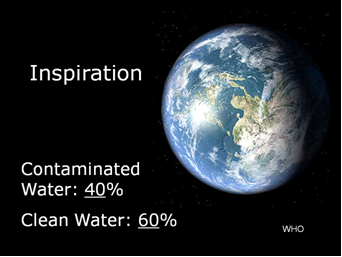Lead
From 2007.igem.org
(Difference between revisions)
| Line 107: | Line 107: | ||
[[Image:Inspiration.jpg]] | [[Image:Inspiration.jpg]] | ||
| - | According to the WHO, 40% of the planet does not have access to clean water. Lead is a serious contaminant around the world. It can cause neurological disorders, anemia, and death. In the United States alone, 3.5 million people have high levels of lead in their blood, so the problem is prevalent in both the developed and developing world. Children under the age of 12 are most at risk for lead poisoning. For more on lead poisoning | + | According to the WHO, 40% of the planet does not have access to clean water. Lead is a serious contaminant around the world. It can cause neurological disorders, anemia, and death. In the United States alone, 3.5 million people have high levels of lead in their blood, so the problem is prevalent in both the developed and developing world. Children under the age of 12 are most at risk for lead poisoning. For more on lead poisoning, click [http://www.aquasanastore.com/water-you_c04.html here]. |
(Once you click, show this image.) | (Once you click, show this image.) | ||
| Line 117: | Line 117: | ||
(Chen P, Greenberg B, Taghavi S, Romano C, van der Lelie D, He C (2005) An exceptionally selective lead(II)-regulatory protein from Ralstonia metallidurans: development of a fluorescent lead(II) probe. Angew Chem Int Ed Engl 44:2715–2719) | (Chen P, Greenberg B, Taghavi S, Romano C, van der Lelie D, He C (2005) An exceptionally selective lead(II)-regulatory protein from Ralstonia metallidurans: development of a fluorescent lead(II) probe. Angew Chem Int Ed Engl 44:2715–2719) | ||
| + | =Design= | ||
| + | Having found a Lead Binding Protein and its corresponding Lead Promoter in the literature, we began to generate a number of ideas for our lead detector design. We began with a simple detector: The lead promoter could be placed in front of Green Fluorescent Protein, GFP. Once lead enters the cell, it activates the Lead Binding Protein, which activates our Lead Promoter, which in turn gives us some GFP output. But we realized that we could make this simple detector much more effective with an amplification circuit. | ||
| + | |||
| + | [Image:Lead Switch.jpg] | ||
| + | |||
| + | |||
| + | =Experimental Steps= | ||
| + | We have three experimental steps to create our final product: | ||
| + | 1. Develop an assay to measure AHL | ||
| + | 2. Characterize our amplifier | ||
| + | 3. Characterize our new parts: the lead promoter and the lead binding protein | ||
| + | [Image:Experiment.jpg] | ||
Revision as of 00:30, 27 October 2007

